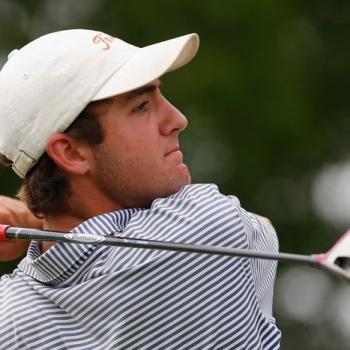Jordan Spieth is the new kid on the block on the PGA Tour. This 21-year old Texan is now headed for superstardom by winning the Masters in April and the U.S. Open yesterday. Those are the first two of the four major championships in the world of professional golf. Only six pros have ever won the first two majors of the years Plus, Spieith is the youngest to win the first two since Gene Sarazen, called The Squire, did so in 1922 at age 20 by winning the U.S. Open and the PGA Championship.
This U.S. Open was held at a relatively new and very different golf course located in my old stomping grounds–the beautiful, mountainous Pacific Northwest. I was born and reared in Seattle, Washington. Chambers Bay Golf Course is located a few miles away, near Tacoma, in University Place. It is a public, British links-style track designed and built by the famous architect Robert Trent Jones Jr. It covers 250 acres, which is a lot of real estate for a golf course. Opened in 2007, it lies atop a reclaimed sand and gravel quarry that fronts on Puget Sound. Being nearly 7,800 yards in length, it is the longest venue with the most up and down elevation of any golf course for a U.S. Open. Spectators complained of difficulty in walking and seeing the tournament. The only major tournament played there previously had been the U.S. Amateur in 2010. Jordan Spieth had a slight edge on this field since he competed in that tournament at age sixteen. Nearly all the rest of the contestants had never seen the layout.
Chambers Bay is a very controversial golf course. Just watching the tournament on television, I’ve never seen anything like it, not even in the Old Country. The ball bounced and rolled every which way due especially to such severely contoured, fast greens. The fairways and greens are planted in fescue grass. Most of the golf course, including fairways and greens, was lightly green to brown in color. It looked like a golf course suffering summer drought with no water spinkling system. It sure didn’t look like a playground for what I’ve always considered the greatest game on grass–the U.S. Open Golf Championship.
I have never played a golf course that has completely fescue fairways, let alone fescue greens. Fescue grass is a very narrow, dry, sturdy blade that requires less moisture than most grasses on golf courses. I have always wondered why fescue was not used more on fairways. But I would never think of it for greens. Fescue is too tough and thus not smooth enough to allow to ball to roll truly. And on the West Coast, golf greenskeepers struggle with poa annua. During this tournament, as each day progressed the poa annua would grow but the fescue didn’t. Thus, later in the day, and with the addition of human trafficking, its mostly the poa annua that causes a golf ball to roll irregularly. So, contestants were missing lots of short putts that was uncharacteristic for a major golf tournament.
Players and media thus made the design and condition of Chamber Bay the centerpiece of discussion of this tournament. Contestants constantly had to aim their full shots, chips, and putts abnormally away from the hole location to allow the contour of the green cause the ball to often roll at right angles of the initial direction of the shot. But most amazing was the countless times when a player intentionally would strike his ball or hit his putt to some side or back of the green and watch the ball roll for long distances sideways or backwards. It made viewers wonder how a player could decide where to aim the shot. It looked like such a guessing game. I called it “crazy golf,” “gooney golf,” and “putt-putt.” Yes, it had some similarly to minature golf.
This tournament had several interesting stories and a most chaotic finish. There was Jason Day, a PGA Tour regular from Australia. See my next post about him getting Vertigo. Back to the tournament yesterday. Besides the controversy about the golf course, the main talk has been Dustin Johnson. One television announcer earlier in the week said he looks and walks like a “gunslinger.” He sure does. He could take Clint Eastwood’s place in western movies. I have always liked to watch long hitters in golf. Dustin hits the ball really far and yet looks like it does it effortlessly even though he has a pretty long backswing. He’s six feet, four inches tall with long arms, all of which helps a long hitter. Even more than Jason Day, Dustin Johnson has been knocking on the door to win his first major golf tournament. He has led in three majors the final round and had unfortunate collapses, including an 82, OB ball, and a rules infraction. Last week, he was constantly blasting his drives in the fairway, hitting good iron shots, and lipping out putts, especially on the last nine holes yesterday.
Several player were bunched at the top yesterday, and the lead changed hands many times. Johnson led but was overtaken by Spieth. The seventeenth hole is a 200+ par-three. Jordan Spieth and Brandon Grace were playing together. They came to the seventeenth hole tied for the lead, with Dustin Johnson now three shots back. Grace practially shanked his iron shot way, way right and the ball went out of bounds, which no one else probably did all week. Then Spieth hit his iron shot way right so that both players finished with a double bogey. Johnson, playing in the next and last group, hit a magnificent iron shot on seventeenth hole about six feet and made the birdie putt. Spieth birdied the par-five eighteenth hole to finish the tournament with the lead, one shot ahead of Johnson and Louis Oosthiuzen, who finished with a phenomenal six birdies the last seven holes for the first 29 on the closing nine holes in Open history.
The 600-yard eighteenth hole at Chambers Bay looks like Alfred Hitchcock designed it. Dustin Johnson absolutely hammered that ball so far it looked like it would never come down. Then he hit the most pure five iron that rested twelve feet from the hole, putting for an eagle. But the green was very slick, and the putt was downhill. If Johnson makes it, he wins. But he rolled it past the hole three feet. Then he surprisingly missed that second putt to finish one shot shy of winner Jordan Spieth. Dustin therefore had suffered another mishap in a major championship, now his fourth. A two-putt would have resulted in Johnson and Spieth playing an eighteen-hole playoff today. So, in that position wisdom says lag that first putt, since it’s so fast downhill, and ensure at least a playoff tomorrow. It was Dustin Johnson’s most bitter pill to swallow so far in what looks like should be such an illustrious career.
Dustin Johnson afterwards refused to speak to the televized media Q&A and even participate in the after-tournament ceremonies, which is very traditional. He was criticized for both. But he did answer journalists’ questions soon after he finished the tournament, and we saw that on national television. He handled himself very well right after a most disappointing loss, and in this he was a credit to the USGA, the PGA Tour, and the game of golf.
The youthful-looking and polite, yet very confident, 21-year old Jordan Spieth handled himself as a most credible champion as well. He paid much tribute to Dustin Johnson and said he felt for the guy. Right away, the media began questioning Jordan about his now rare opportunity to attain the holy grail in golf by winning the Grand Slam, that is, winning the four majors in golf in the same year–the Masters, U.S. Open, British Open, and PGA Championship. No one has ever done it, though amateur star Bobby Jones won the Grand Slam for an amateur golfer in one year–the U.S. Amateur, U.S. Open, British Amateur, and British Open. Listening to this young wipper snapper Jordan Spieth field these questions about the Grand Slam, he made you think he might just be able to pull if off. He talked about not hitting the ball that well in this U.S. Open. He admitted making several mistakes, especially his bad iron shot on seventeen hole that day. He said, “I don’t know why I did that.”
Ha! It’s the U.S. Open, young man! He knows the pressure is so intense on those final holes when you are in the hunt. But Jordan Spieth has an advantage at every tournament. The best thing about his golf game is his putting. He is such a terrific putter.
Other than the short game, when Jordan Spieth gets ready to hit a shot he constantly makes a little half swing back and forth with his club. It’s obvious to me why he’s doing that. Jordan Spieth is all about rhythym swing the club with rhythym, even with his putter. That to me is what makes him such a good golfer. He’s got fantastic rhythym in his swing. And he’s got pretty good balance in his swing, so that his weight shifts adequately. However, he wasn’t doing that very well on some uphill shots. Most of time, his feet stay pretty stationary, which I think is the most underrated component in the golf swing. No golfer ever shifted his weight and stayed in balance with his feet than did the great Ben Hogan.
But I have one criticism of Jordan Spieth’s golf swing which I think is the cause of his blocked iron shot yesterday on seventeen hole, which resulted in a double bogey that could have lost him the tournament. Spieth’s slow motion swings on TV reveal that he does not quite have his left arm straight at impact. That causes his left elbow to lead past impact on his follow through. That often causes the clubface to be open, thus aimed to the right of the target line, at impact, resulting in a missed shot to the right. Under pressure, many golfers tend to “look up” with their head and thus straighten their spine, which also results in the clubface aiming to the right of the targetline at impact. Jordan Spieth did both on his iron shot on the seventeenth hole yesterday. So, he just needs to remember to “stay down” in those pressure situations. I noticed him doing that same thing in the closing holes of televized tournaments earlier this year in which he finished second. He should go talk to Lee Trevino there in Dallas where they both live. No one ever stayed down through the shot better than the Supermex. And what a great pressure player Lee Trevino was.
Ben Hogan was the greatest ballstriker of all time. He was also known for not giving golf lessons. Yet he once told me one thing, and the only one, about my golf swing. He said my left elbow was swinging around too much on my follow through. It was very similar to what Jordan Spieth does. Pros call it a “block.” Thus, the proper way for right-handed golfers to swing the club is to have the left arm straight at impact to achieve maximum extension and thus clubhead speed, with both arms straight then or soon after impact, and the right arm crossing over the left arm on the upswing so that the clubface turns to the same degree that it turns on the backswing in comparable positions. On the finish, the elbows should lag behind the hands so that the arms finish in a folded, rather relaxed position. (But all of this does not apply to golfers who swing shut-to-open or when a golfer hits a punch shot.) Some of the best examples of such a finish are Jack Nicklaus and Tom Watson.
I like Dustin Johnson’s putting stroke. Yet for such a good player, he is about 100th or more in putting. If he could putt better, he’d be a world beater. With Dustin Johnson’s missed short putt on the last hole yesterday, it was just the opposite. Even though he made his usual smooth stroke, just before Dustin struck the ball his head started to pull back away from the hole. When this happens in the full golf swing, some instructors call it “upper body recoil.” It results in the clubface rotating too quickly and thus aiming left of the initial targetline at impact. The result is a miss to the left just as Dustin did on that short putt. So, he just needs to remember in pressure situations to keep his head still at impact on those short putts. He does it great on his full shots. I never see him looking up or pulling back with his head through the impact area.
I once played golf in the Doral pro-am with the great, Yankee, baseball hitter Joe DiMaggio. He also had a good golf swing. When we finished the round I asked Joe, “what did you think of most when you hit a baseball.” Interestingly, he answered, “It’s the same in golf. Keep you eye on the ball.”
The U.S. Open was always my favorite golf tournament. I played in it twelve times and made the 36-hole cut, and thus finished the tournament, eight times. My two best finishes were thirteenth in 1969 at Champions Golf Club in metro-Houston, my hometown, and sixth in 1972 on my favorite golf course, Pebble Beach Golf Links. In 1972, I had a chance to win the tournament but balooned the last round to finish with an embarrassing 79. In the third round I was tied for the lead on the seventeenth hole. On the fourth round I was the sole leader as I approached the short par-3 seventh hole. Jack Nicklaus was one stroke behind me. The greens were baked that week, and Jack later said of them that the grass was “dying.” I hit my wedge shot to the center of the seventh green for a twenty- putt. I hit that first putt eighteen inches short of the hole.
In those days, all golfers wore golf shoes that had metal spikes. Those spikes often left spike marks on the greens. The worst spike marks were the kind that pulled a small piece of turf up and stayed that way. Of course, just as it is today, it was illegal to repair spike marks in the line of your putt before you putted. I had one of those pulled-up spike marks right in the middle of the line of my short putt. I inwardly fretted about. I hit a perfect putt, but the ball caroomed off that spike mark and didn’t even touch the hole to result in a 3-putt. To say the least, it was most unnerving.
The next hole is the beautiful, par-four seventh in which you must hit a lay-up on your first shot to a blind, elevated fairway. From there you hit a medium ironshot over an exansive cavern that includes the Pacific Ocean to the green below. I hit a great six-iron second shot to six feet short of the hole putting straight uphill. Due to that previous, unfortunate 3-putt, I got too bold trying to make it and jammed that very uphill putt three feet past the hole. That is something you should NEVER do. I now had a very downhill putt on a very slick green. That second putt missed the hole and stopped eight feet from the hole. So, my third putt was now on the same line as my first putt had been, yet farther from the hole. Talk about feeling STUPID. At least I made that putt for another 3-putt green. Then I fell apart on the next hole and made double bogey.
But worst of all, on the par-five fourteenth hole I had a wedge shot from the junior rough. The fourteenth green is a double green in which the pin was located on the very small, left, top level. I should have played conservatively from that short rough to the larger portion of the green to the right of the pin. But again, lacking patience I chose too much risk because of being upset from wasting all those previous strokes. I went for the pin on that third shot and the ball barely lacked clearing the sand bunker near the hole location. It was buried severely. I then could only extricate the ball on my fourth shot by going over the green. I finished the hole with a snowman–eight.
My dad was there watching me play that final round. He afterwards said, “When you made that eight I turned green. You spent more money in five minutes than I make in a year.” Well, him turning green is quite appropriate. I’m a junior. It isn’t easy being green.














